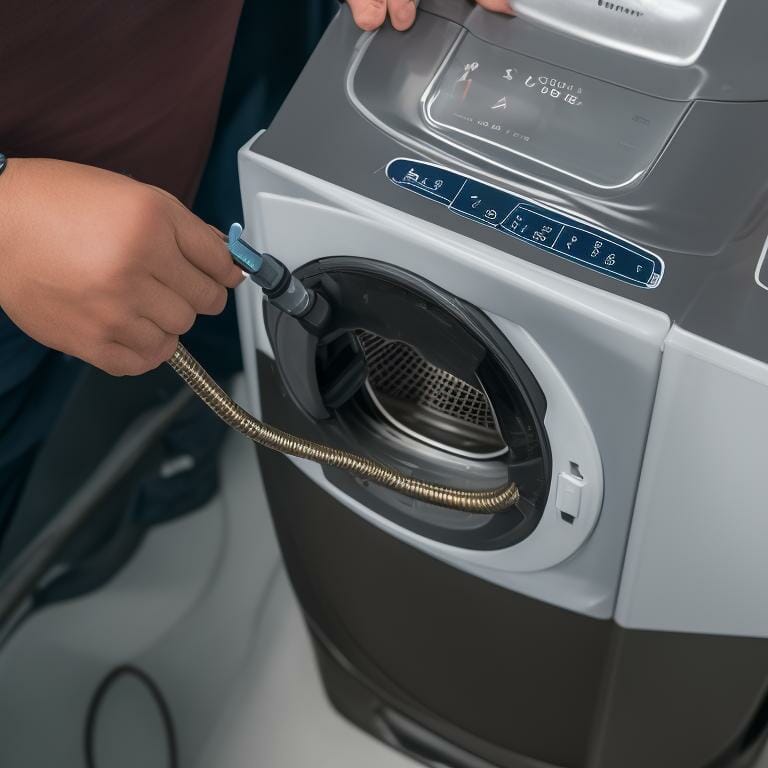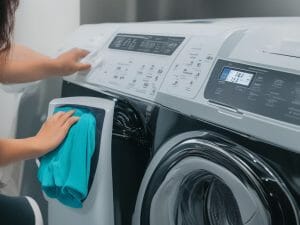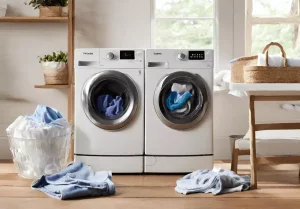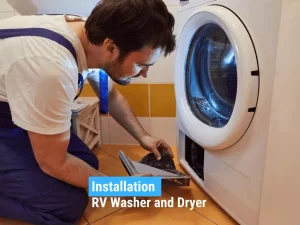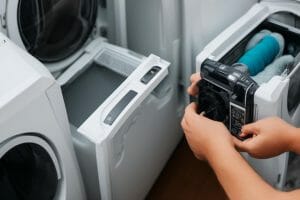Step-by-Step Guide to Hooking Up a Portable Washer
Are you tired of spending hours at the laundromat or lugging heavy loads of laundry up and down the stairs?
Well, did you know that 80% of people who invest in a portable washer experience a significant decrease in their laundry time?
In this step-by-step guide, we will show you how to easily hook up your own portable washer, saving you time, energy, and money.
So, let’s get started and create a laundry routine that gives you a sense of belonging in your own home.
Gather the Necessary Tools and Materials
You’ll need to gather the necessary tools and materials before you can start hooking up your portable washer.
- Make sure you have the right detergent for your machine. Look for a detergent that is specifically designed for portable washers, as they are formulated to work efficiently in smaller water capacities. Choosing the right detergent will ensure that your clothes come out clean and fresh.
- Proper maintenance techniques are essential to keep your portable washer running smoothly. Regularly clean the lint filter to prevent clogs and ensure efficient drainage. Be sure to wipe down the exterior and drum after each use to prevent the buildup of dirt and grime.
Following these maintenance techniques will help extend the lifespan of your portable washer and keep it in optimal working condition.
Find the Ideal Location for Your Portable Washer
When finding the ideal location for your portable washer, there are three key points to consider:
- Space and accessibility: You want to make sure that you have enough space to comfortably accommodate the washer and have easy access to it.
- Plumbing and drainage options: You need to determine the plumbing and drainage options available in the chosen location, as this will determine how you connect and dispose of water.
- Considerations for noise: It’s important to consider the noise levels of the washer, especially if you live in an apartment or have neighbors close by, so you can choose a location that minimizes disruption.
Space and Accessibility
To maximize space and accessibility, make sure there is enough clearance around the portable washer for easy maneuvering. Utilizing your space efficiently is crucial when setting up your portable washer.
By optimizing accessibility, you can ensure a smooth and hassle-free laundry experience. To help you visualize the importance of space utilization and accessibility, here is a table that highlights the dimensions and requirements for your portable washer setup:
| Aspect | Dimensions | Clearance Required |
|---|---|---|
| Width | 24 inches | 3 inches |
| Depth | 20 inches | 3 inches |
| Height | 34 inches | 6 inches |
| Side Clearance | N/A | 6 inches |
Plumbing and Drainage Options
For optimal plumbing and drainage options, ensure that you have access to a nearby water source and a proper drainage system.
When it comes to plumbing installation for your portable washer, it is crucial to have a reliable water supply. You can connect the washer directly to a faucet or use a specialized adapter for a more secure connection.
Additionally, a proper drainage system is essential for efficient water disposal. While traditional methods involve connecting the washer to a nearby sink or using a laundry sink with a built-in drain, alternative drainage methods can be explored. These may include using a portable pump to drain the water into a bucket or connecting the washer to a designated floor drain.
Considerations for Noise
Take into consideration the noise level of your portable washer, as it may impact your overall experience and the environment in which it is used. To ensure a quieter laundry experience, here are some tips to reduce vibration and soundproof your portable washer:

Set up the Water Supply and Drainage System
Make sure you’ve positioned the portable washer near a water source and a drain before connecting the water supply and drainage system.
When it comes to the water supply, you have a few options. If you have access to a standard faucet, you can use a faucet adapter to connect the washer. Another option is to use a fill hose that can be connected to a nearby sink or shower. Just make sure the water supply is turned on and the hose is securely attached.
For the drainage system, you’ll need to install a drain hose. This hose should be connected to a drain or sink, allowing the water to flow out easily. Double-check that the hose is properly connected and that there are no kinks or blockages that could impede the flow of water.
With the water supply and drainage system set up correctly, you can now confidently use your portable washer.
Connect the Hoses and Electrical Components
Now that you have set up the water supply and drainage system for your portable washer, it’s time to connect the hoses and electrical components.
Follow these steps to ensure a smooth and secure connection:
Adjust the Settings and Test the Washer
Now that you’ve successfully connected the hoses and electrical components, it’s time to adjust the settings and test your washer.
Proper washer configuration is crucial to ensure optimal performance and prevent any potential issues. You should also test the water flow to ensure that it’s at the desired level.
Additionally, adjust the spin speed according to your preference and the type of laundry you’re washing.
Proper Washer Configuration
To ensure proper washer configuration, it’s important to position the machine on a flat and stable surface. This will prevent any unnecessary movement or vibrations during the washing cycle. Here are some key steps to follow for a successful washer installation and portable laundry setup:
- Level the machine:
- Use a level to ensure the washer is perfectly horizontal.
- Adjust the adjustable feet to achieve a balanced position.
- Secure the machine:
- Use anti-vibration pads or a non-slip mat to prevent the machine from sliding.
- Make sure the machine is securely placed to avoid accidents or damage.
Testing Water Flow
To ensure proper water flow, it’s essential to check the hoses for any kinks or obstructions before starting a washing cycle. Begin by examining the hoses from the portable washer to the faucet and make sure they are free from bends or twists.
Next, ensure that the water valves on both the washer and the faucet are fully open. This will ensure adequate water pressure for a successful wash.
Additionally, it’s crucial to verify the water temperature settings on the washer. Some portable washers have options for hot, cold, or warm water, so select the appropriate setting based on your laundry needs.
Adjusting Spin Speed
Make sure you adjust the spin speed on the washer according to the type of clothing you are washing. This is an important step to ensure that your clothes are cleaned effectively and that they last longer.
Here are some key points to help you with spin speed adjustment:
Remember, the optimal laundry load for your washer is typically mentioned in the user manual. Overloading the washer can lead to poor cleaning results and excessive wear on the machine.
Maintain and Troubleshoot Your Portable Washer
If your portable washer isn’t functioning properly, you may need to check the water supply and ensure it is connected securely. Proper maintenance is essential to keep your portable washer running smoothly. Here are some troubleshooting tips to help you maintain and troubleshoot your portable washer.
- Make sure the water supply is turned on and the hose is securely connected to both the washer and the faucet. Check for any kinks or blockages in the hose that may be restricting water flow. If the water supply is fine, check the power source and make sure the washer is properly plugged in.
- Ensure that the washer is level on the floor. An uneven surface can cause the washer to vibrate excessively and produce loud noises during operation.
- Clean the lint filter and drain pump to prevent clogs and improve performance. Refer to the user manual for instructions on how to clean these components.
- If the issue persists, contact the manufacturer or a professional technician for further assistance. Remember, proper maintenance and troubleshooting can help prolong the life of your portable washer and ensure its efficient operation.
Frequently Asked Questions

How Do I Clean the Inside of My Portable Washer?
To clean the inside of your portable washer, try these cleaning techniques and maintenance tips. Start by unplugging the machine and removing any debris. Then, use a mixture of vinegar and water to wipe down the interior. Don’t forget to clean the filters regularly for optimal performance.
Can I Use Hot Water in My Portable Washer?
Yes, you can use hot water in your portable washer. However, using cold water is recommended for better performance and to prevent damage. It’s an important part of portable washer maintenance.
What Should I Do if My Portable Washer Is Leaking?
If your portable washer is leaking, there are a few troubleshooting tips you can try. Common causes include loose connections or a damaged hose. Check them carefully and tighten or replace as needed.
Is It Safe to Leave My Portable Washer Unattended While It’s Running?
It’s not safe to leave your portable washer unattended while it’s running. Neglecting maintenance and leaving it alone can lead to potential risks like leaks, electrical issues, or even flooding.
How Often Should I Clean the Lint Filter in My Portable Washer?
To keep your portable washer running smoothly, it’s important to clean the lint filter regularly. Neglecting this maintenance can lead to common issues like clogged drains and reduced performance.
Conclusion
In conclusion, you’ve successfully hooked up your portable washer by following this step-by-step guide.
By gathering the necessary tools and materials, finding the ideal location, setting up the water supply and drainage system, connecting the hoses and electrical components, adjusting the settings, and testing the washer, you are now ready to enjoy the convenience of this appliance.
Remember, ‘a stitch in time saves nine,’ so make sure to maintain and troubleshoot your portable washer regularly to avoid any future issues.
Enjoy your clean and hassle-free laundry experience!

